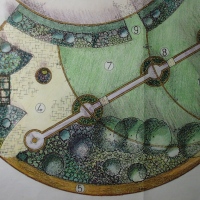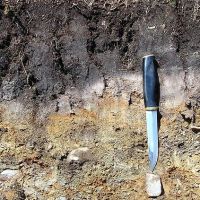Yesterday was sunny but breezy, so my wife and I and two friends went out for a delightful walk in the local countryside, followed by Sunday lunch at a local pub. On the walk we came across signs to a ‘bluebell event’ and passed by the house and garden where this was taking place, but alas, could not spot any but a couple of rather weak looking bluebell blooms. Having been attracted out to another such event publicised a week or so ago (when in a ‘normal’ spring the Bluebells should have been well into flower) and been disappointed, I was skeptical that there was any real show on offer, especially as the bluebells at ‘Old School Garden’ were nowhere to be seen other than making a few clumps of lush foliage!
So, the late spring was once again (not) in evidence! We did, however, see some patches of Wood Anemone (Ranunculus nemorosus, meaning found in groves) amongst larger swathes of Lesser Celandine (Ranunculus ficaria, meaning fig like, referring to the heart- shaped leaves), that reliably invasive yellow – flowered creeper. According to Gilbert White, the famous diarist writing around 1800, the Lesser Celandine flowers came out on February 21, but it is more commonly expected between March and May these days, and is sometimes called the “spring messenger”.
The name Ranunculus comes from the latin for “little frog,” (rana = frog and a diminutive ending). This probably refers to many species being found near water – just like frogs! It is a large genus of about 600 species in the similarly named family Ranunculaceae. Members include buttercups, spearworts, water crowfoots as well as the lesser Celandine. According to the Oxford English Dictionary, Celandine comes from the latin chelidonia, meaning swallow: it was said that the flowers bloomed when the swallows returned and faded when they left. The common name Celandine is used to describe three different plants; as well as Lesser Celandine (a Ranunculus) there is Greater Celandine (Chelidonium majus, in the poppy family) and the Celandine Poppy (Stylophorum diphyllum, also in the poppy family).
Other Ranunculus species names are:
R. aconitifolius = aconite (aconitum) – like leaves
R. acris = sharp or bitter – the Meadow Crowfoot or Buttercup, a double flowered variety is grown in gardens
R. amplexicaulis = leaves, stem clasping
R. anemonoides = anemone – like
R. asiaticus = Asian, the Persian Ranunculus
R. crenatus = leaves crenated or scalloped
R. glacialis = icy, a high alpine plant
R. gramineus = grassy – the leaves
R. lingua = a tongue – the shape of the leaves
R. lyallii = after David Lyall (a 19th century Scottish botanist), the Rockwood or Mount Cook Lily
R. nivalis = snowy, or lofty regions
R. nyssanus = from Nyssa (an ancient city in Turkey)
R. parnassifolius = leaved like Parnassia
R. repens = creeping or crawling, the Creeping Buttercup
R. rutaefolius = rue (Ruta) – leaved
Most Ranunculus are herbaceous perennials, with bright yellow or white flowers (if white, they still come with a yellow centre), though some are annuals or biennials. A few species have orange or red flowers. There are usually five petals, but sometimes six, numerous, or none, as in R. auricomus. The petals are often highly lustrous, especially in those with yellow flowers (e.g buttercups).
Buttercups usually flower in the spring, but flowers may be found throughout the summer, especially where they are unwelcome garden weeds! The name buttercup may derive from a false belief that the plants give butter its characteristic yellow hue (in fact it is poisonous to cows and other livestock). A popular children’s game involves holding a buttercup up to the chin; a yellow reflection is supposed to indicate a fondness for butter!
In the interior of the Pacific Northwest of the United States the buttercup is called “Coyote’s eyes”. In the legend behind this the Coyote was tossing his eyes up in the air and catching them again when the Eagle snatched them. Unable to see, Coyote made eyes from the buttercup!
Ranunculus species are used as food plants by the larvae of some butterflies. Some species are popular ornamental flowers, and many cultivars have large and brightly coloured flowers. When Ranunculus plants are handled, a naturally occurring substance, ranunculin is broken down to form a toxin known to cause dermatitis in humans and care should therefore be taken when handling large numbers of the plants. The toxins are degraded by drying, so hay containing dried buttercups is safe.
The Lesser Celandine plant used to be known as Pilewort because it was used to treat haemorrhoids. Supposedly, the knobbly tubers of the plant resemble piles, and according to the ‘doctrine of signatures’ this resemblance suggests that Pilewort could be used to cure piles! The German vernacular Scharbockskraut (“Scurvyherb”) derives from the use of the early leaves, which are high in vitamin C, to prevent scurvy. The plant is widely used in Russia and is sold in most pharmacies as a dried herb.
Further information:
Ranunculus ficaria ‘Brazen Hussy’
Quizzicals:
answers to the two clues given in Plantax 9…
- Substandard animal limb = Pawpaw
- West Indies batsman + Food superstore = Vivaldi
..and 2 more cryptic clues to the names of plants, fruit or veg…
-
Evader of women
- Oriental busybody
(thanks to Les Palmer, answers in the next Plantax!)
Old School Gardener
If you’ve enjoyed reading this post and others on this blog, why not comment and join others by signing up for automatic updates via email (see side bar, above right ) or through an RSS feed (see top of page)?















